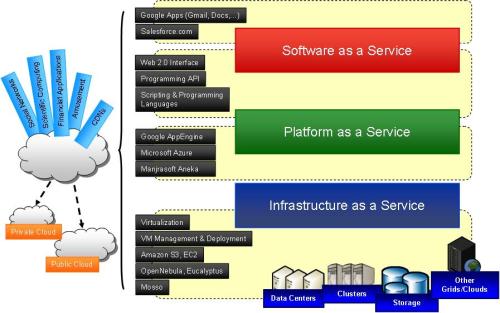Cloud Ready
November 12, 2009 at 12:25 pm | Posted in Cloud Computing 101 | Leave a commentTags: architecture, Cloud computing, cloud computing overview
With the advancement of the modern human society, basic and essential services are delivered almost to everyone in a completely transparent manner. Utility services such as water, gas, and electricity have become fundamental for carrying out our daily life and are exploited on a pay per use basis. The existing infrastructures allow delivering such services almost anywhere and anytime so that we can simply switch on the light, open the tap, and use the stove. The usage of these utilities is then charged, according to different policies, to the end user. Recently, the same idea of utility has been applied to computing and a consistent shift towards this approach has been done with the spread of Cloud Computing.
Cloud Computing is a recent technology trend whose aim is to deliver on demand IT resources on a pay per use basis. Previous trends were limited to a specific class of users, or focused on making available on demand a specific IT resource, mostly computing. Cloud Computing aims to be global and to provide such services to the masses, ranging from the end user that hosts its personal documents on the Internet, to enterprises outsourcing their entire IT infrastructure to external data centers. Never before an approach to make IT a real utility has been so global and complete: not only computing and storage resources are delivered on demand but the entire stack of computing can be leveraged on the Cloud.

Figure 1. Cloud Computing architecture.
Figure 1 provides an overall view of the scenario envisioned by Cloud Computing. It encompasses so many aspects of computing that very hardly a single solution is able to provide everything that is needed. More likely, specific solutions can address the user needs and be successful in delivering IT resources as a real utility. Figure 1 also identifies the three pillars on top of which Cloud Computing solutions are delivered to end users. These are: Software as a Service (SaaS),Platform as a Service (PaaS), and Infrastructure/Hardware as a Service (IaaS/HaaS). These new concepts are also useful to classify the available options for leveraging on the Cloud the IT needs of everyone. Examples of Software as a Service are Salesforce.com[1] and Clarizen.com[2], which respectively provide on line CRM and project management services. PaaS solutions, such as Google AppEngine[3], Microsoft Azure[4], and Manjrasoft Aneka provide users with a development platform for creating distributed applications that can automatically scale on demand. Hardware and Infrastructure as a Service solutions provide users with physical or virtual resources that are fitting the requirements of the user applications in term of CPU, memory, operating system, and storage. These and any others QoS parameters are established through a Service Level Agreement (SLA) between the customer and the provider. Examples of this approach are Amazon EC2[5] and S3[6], and Mosso[7].
It is very unlikely that a single solution provides the complete stack of software, platform, infrastructure and hardware as a service. More commonly, specific solutions provide services at one (or more) of these layers in order to exploit as many as possible the opportunities offered by Cloud Computing. Within this perspective, Aneka provides a platform for developing distributed applications that can easily scale and take advantage of Cloud based infrastructures. Aneka is software framework based on the .NET technology initially developed within the Gridbus project [2] and then commercialized by Manjrasoft[8]. It simplifies the development of distributed applications by providing: a collection of different ways for expressing the logic of distributed applications, a solid infrastructure that takes care of the distributed execution of applications, and a set of advanced features such as the ability to reserve and price computation nodes and to integrate with existing cloud infrastructures such as Amazon EC2.
—————————————————————————-
[3]http://code.google.com/appengine/docs/whatisgoogleappengine.html
[4]http://www.microsoft.com/azure/
—————————————————————————-
Create a free website or blog at WordPress.com.
Entries and comments feeds.